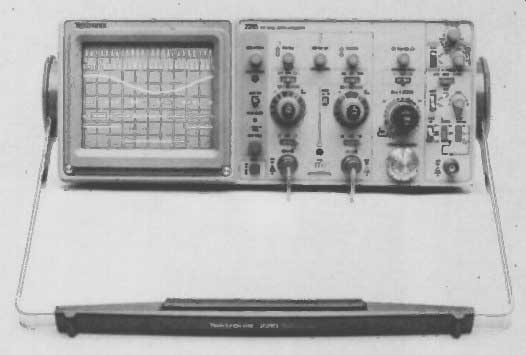By Walter H. Schwartz & Peter B. Credit

------ The Tektronix 2215 oscilloscope.
Tektronix has apparently decided to meet and to attempt to better both the domestic and import competition in the wideband general purpose portable oscilloscope market. The 2213 and 2215 are 60 MHz (50 MHz at the 2-5-10 my attenuator settings) dual trace single and dual time base scopes, respectively. They offer a full range of basic features attractively packaged in traditional Tek blue and reportedly use the CRT originally used in the much more expensive 465 series.
We found the bandwidth of the 2215 to be approximately - 6 dB at 75 MHz at the 20 my to 10y per division settings, at the 2, 5, and 10 mil, settings manufacturers specifications rate it at dc to 50 MHz. The input attenuator offers deflection factors of 2 mµ per division to 10v per division with an accuracy of ±3%. The rise time is rated at 5.8ns or less, maximum safe input voltage is specified to be 400v (dc + peak ac) or 800v p-p ac to 1kHz or less.
With the vertical mode switches set to BOTH and ADD, the waveform displayed is the algebraic sum of the signals applied to both channel 1 and 2 inputs. If the channel 2 INVERT push button is pressed in, the waveform displayed is the difference between the signals applied to the channel 1 and channel 2 inputs.
Pushing the BEAM FIND pushbutton will cause the display to reappear on the screen if it has moved off thus allowing for quick location of a missing wave form.
Triggering modes are auto, norm, and TV field and function normally for a scope of this type.
The sweep rate for A sweep is 0.5 second per division to 0.05µs per division in a 1-2-5 sequence, the B sweep rate is 50ms per division to 0.05µs per division. Delay time applies to sweep speed settings of 0.5µs per division and slower, the B delay time position control range is less than 0.5s per division to more than 10 divisions.
Delayed sweeps are always fun though sometimes confusing, (they re quire reading of the instruction manual), since delayed sweep features vary from scope model to scope model -I always have liked the mixed mode some of the more expensive Tektronix and Telequipment scopes have--and the 2215 also requires full understanding. In the 2215, the A sweep displays the desired signal; the B sweep displays that portion of the A sweep which is intensified, The B sweep speed in the delay time position control determines this segment. It works very nicely.
The 2215 has all the features one would expect of a portable/bench scope.
The controls are convenient--even the concentric functions; the human engineering was done properly. The only complaint we had was that the automatic intensity control circuit allowed the trace to run out of intensity on very fast pulses, 0.05 µsec, at low repetition rates, 100 Hz or so. However, I do not know how often this situation would arise in other than lab tests. At repetition rates of 500 Hz or so there is more than adequate intensity.
The 2213 sells for $1100 and the dual time base 2215 sells for $1400. They weigh approximately 17 lbs, are of sturdy construction--we examined the 2215 closely--and meet fairly rigorous environmental requirements.
(source: Electronic Technician/Dealer)